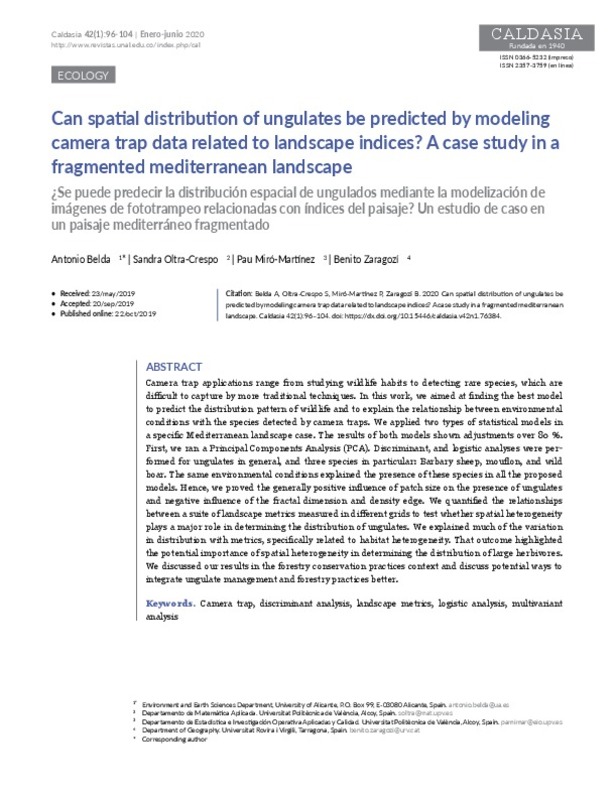Abdul-Wahab SA, Bakheit CS, Al-Alawi SM. 2005. Principal component and multiple regression analysis in modelling of ground-level ozone and factors affecting its concentrations. Environ Model Softw. 20(10):1263–1271. doi: https://doi.org/10.1016/j.envsoft.2004.09.001.
Acevedo P, Farfán MA, Márquez AL, Delibes-Mateos M, Real R, Vargas JM. 2011. Past, present and future of wild ungulates in relation to changes in land use. Landsc Ecol. 26(1):19–31. doi: https://doi.org/10.1007/s10980-010-9538-2.
Agarwal C, Green GM, Grove JM, Evans TP, Schweik CM. 2002. A Review and Assessment of Land-Use Change Models: Dynamics of Space, Time, and Human Choice. GTR NE-297. Newton Square, PA: U.S.D.A. Forest Service, Northeastern Research Station. 61 p.
[+]
Abdul-Wahab SA, Bakheit CS, Al-Alawi SM. 2005. Principal component and multiple regression analysis in modelling of ground-level ozone and factors affecting its concentrations. Environ Model Softw. 20(10):1263–1271. doi: https://doi.org/10.1016/j.envsoft.2004.09.001.
Acevedo P, Farfán MA, Márquez AL, Delibes-Mateos M, Real R, Vargas JM. 2011. Past, present and future of wild ungulates in relation to changes in land use. Landsc Ecol. 26(1):19–31. doi: https://doi.org/10.1007/s10980-010-9538-2.
Agarwal C, Green GM, Grove JM, Evans TP, Schweik CM. 2002. A Review and Assessment of Land-Use Change Models: Dynamics of Space, Time, and Human Choice. GTR NE-297. Newton Square, PA: U.S.D.A. Forest Service, Northeastern Research Station. 61 p.
Belda A, Martínez-Perez JE, Peiró V, Seva E, Arques J. 2011. Main landscape metrics affecting abundance and diversity of game species in a semi-arid agroecosystem in the Mediterranean region. Span. J. Agric. Res. 9(4):1197–1212. doi: https://doi.org/10.5424/sjar/20110904-470-10.
Belda A, Zaragozí B, Belda I, Martínez JE, Seva E. 2012. Traditional knowledge of medicinal plants in the Serra de Mariola Natural Park, South-Eastern Spain. Afr J Tradit Complement Altern Med. 10(2):299–309. doi: https://doi.org/10.4314/ajtcam.v10i2.15.
Belda A, Belenguer, R, Zaragozí B, Ferri, V. 2016. Abundance and distribution of European badger – Meles meles (Linnaeus, 1758) in the Sierra de Mariola Natural Park (C. Valenciana). BAGE. 70:467–469. doi: https://doi.org/10.21138/bage.2164.
Botello F, Monroy G, Illoldi-Rangel A, Trujillo-Bolio I, Sánchez-Cordero V. 2007. Systematic images from camera-traps: a proposal of data card. Rev Mex Biodivers. 78:207–210.
Calenge C, Maillard D, Fournier P, Fouque C. 2004. Efficiency of spreading maize in the garrigues to reduce wild boar (Sus scrofa) damage to Mediterranean vineyards. Eur. J. Wild. Res. 50(3):112–120. doi: https://doi.org/10.1007/s10344-004-0047-y.
Can OE, Togan I. 2009. Camera trapping of large mammals in Yenice Forest, Turkey: Local information versus camera traps. Oryx 43(3):427–430. doi: https://doi.org/10.1017/S0030605308000628.
Cassinello J, Acevedo P, Hortal J. 2006. Prospects for population expansion of the exotic aoudad (Ammotragus lervia, Bovidae) in the Iberian Peninsula: clues from habitat suitability modelling. Diversity Distrib. 12:666–678. doi: https://doi.org/10.1111/j.1472-4642.2006.00292.x.
Cuevas MF, Ojeda RA, Jaksic FM. 2013. Multi-scale patterns of habitat use by wild boar in the Monte Desert of Argentina. Basic Appl Ecol. 14(4):320–328. doi: https://doi.org/10.1016/j.baae.2013.03.001.
Cutler TL, Swann DE. 1999. Using remote photography in Wildlife Ecology: a review. Wild. Soc. Bull. 27(3):571–581. Fegraus EH, Lin K, Ahumada JA, Baru C, Chandra S, Youn C. 2011. Data acquisition and management software for camera trap data: A case study from the TEAM Network. Ecol Inform. 6(6):345–353. doi: https://doi.org/10.1016/j.ecoinf.2011.06.003.
Harris G, Thompson R, Childs JL, Sanderson JG. 2010. Automatic storage and analysis of camera trap data. Bull. Ecol. Soc. Amer. 91(3):352–360. doi: https://doi.org/10.1890/0012-9623-91.3.352.
Holloran MJ, Anderson SH. 2003. Direct identification of northern sage-grouse, Centrocercus urophasianus, nest predators using remote sensing cameras. Canad. Fie. Nat. 117(2):308–310. doi: https://doi.org/10.22621/cfn.v117i2.804.
[ICV] Instituto Cartográfico Valenciano. c2005. Ortofoto ODCV05: Comunidad Valenciana-Provincia de Alicante. [last accessed: 15 May 2015]. http://www.icv.gva.es
Kelly MJ. 2008. Design, evaluate, refine: camera trap studies for elusive species. Anim. Conserv. 11:182–184. doi: https://doi.org/10.1111/j.1469-1795.2008.00179.x.
Korre A. 1999. Statistical and spatial assessment of soil heavy metal contamination in areas of poorly recorded, complex sources of pollution. Part 1: factor analysis for contamination assessment. Stoch Environ Res Risk Assess. 13(4):260–287. doi: https://doi.org/10.1007/s004770050043.
Lütolf M, Bolliger J, Kienast F, Guisan A. 2009. Scenario based assessment of future land use change butterfly species distributions. Biodivers. Conserv. 18:1329–1347. doi: https://doi.org/10.1007/s10531-008-9541-y.
Mackenzie D, Nichols J, Lachman G, Droege S, Royle J, Langtimm C. 2002. Estimation site occupancy rates when detection probabilities are less than one. Ecology 83(8):2248–2255. doi: https://doi.org/10.1890/0012-9658(2002)083[2248:ESORWD]2.0.CO;2.
Mcgarigal K, Cushman S A, Neel M C, Ene E. c2002. FRAGSTATS: Spatial pattern analysis program for categorical maps. Univ Massachusetts, Amherst. [last accessed: 07 May 2015]. http://www.umass.edu/landeco/research/fragstats/fragstats.html
Millington JDA, Perry GLW, Romero-Calcerrada R. 2007. Regression Techniques for Examining Land Use/Cover Change: A Case Study of a Mediterranean Landscape. Ecosystems 10(4):562– 578. doi: https://doi.org/10.1007/s10021-007-9020-4.
Rowcliffe JM, Field J, Turvey ST, Carbone C. 2008. Estimating animal density using camera traps without the need for individual recognition. J Appl Ecol. 45(4):1228–1236. doi: https://doi.org/10.1111/j.1365-2664.2008.01473.x.
Royle JA, Nichols JD. 2003. Estimating abundance from repeated presence-absence data or point counts. Ecology 84(3):777–790. doi: https://doi.org/10.1890/0012-9658(2003)084[0777:EA-FRPA]2.0.CO;2.
Silveira L, Jácomo ATA, Diniz-Filho JAF. 2003. Camera trap, line transect census and track survey a comparative evaluation. Biol. Conserv. 114(3):351–355. doi: https://doi.org/10.1016/S0006-3207(03)00063-6.
Smith R, Vaughan N, Robinson A, Harris S. 2004. Conservation of European hares Lepus europaeus in Britain: is increasing habitat heterogeneity in farmland the answer? J. Appl. Ecol. 41(6): 1092–1102. doi: https://doi.org/10.1111/j.0021-8901.2004.00976.x.
Stanley TR, Royle JA. 2005. Estimating site occupancy and abundance using indirect detection indices. J. Wildl. Manage. 69(3):874–883. doi: https://doi.org/10.2193/0022-541X(2005)069[0874:ESOAAU]2.0.CO;2.
Thuiller W, Albert C, Araujo MB, Berry PM, Cabeza M, Guisan A, Hickler T, Midgley GF, Paterson J, Schurr FM, Sykes MT, Zimmermann NE. 2008. Predicting global change impacts on plant species’ distributions: Future challenges. Perspect. Plant Ecol. Evol. Syst. 9(3–4):137–152. doi: https://doi.org/10.1111/j.1365-2664.2007.01416.x.
Yamaura Y, Katoh K, Fujita G, Higuchi H. 2005. The effect of landscape contexts on wintering bird communities in rural Japan. For. Ecol. Manage. 216(1–3):187–200. doi: https://doi.org/10.1016/j.foreco.2005.05.028.
Zaragozí B, Belda A, Giménez P, Navarro JT, Bonet A. 2015. Ad-vances in camera trap data management tools: Towards collaborative development and integration with GIS. Ecol. Inform. 30:6–11. doi: https://doi.org/10.1016/j.ecoinf.2015.08.001.
[-]









